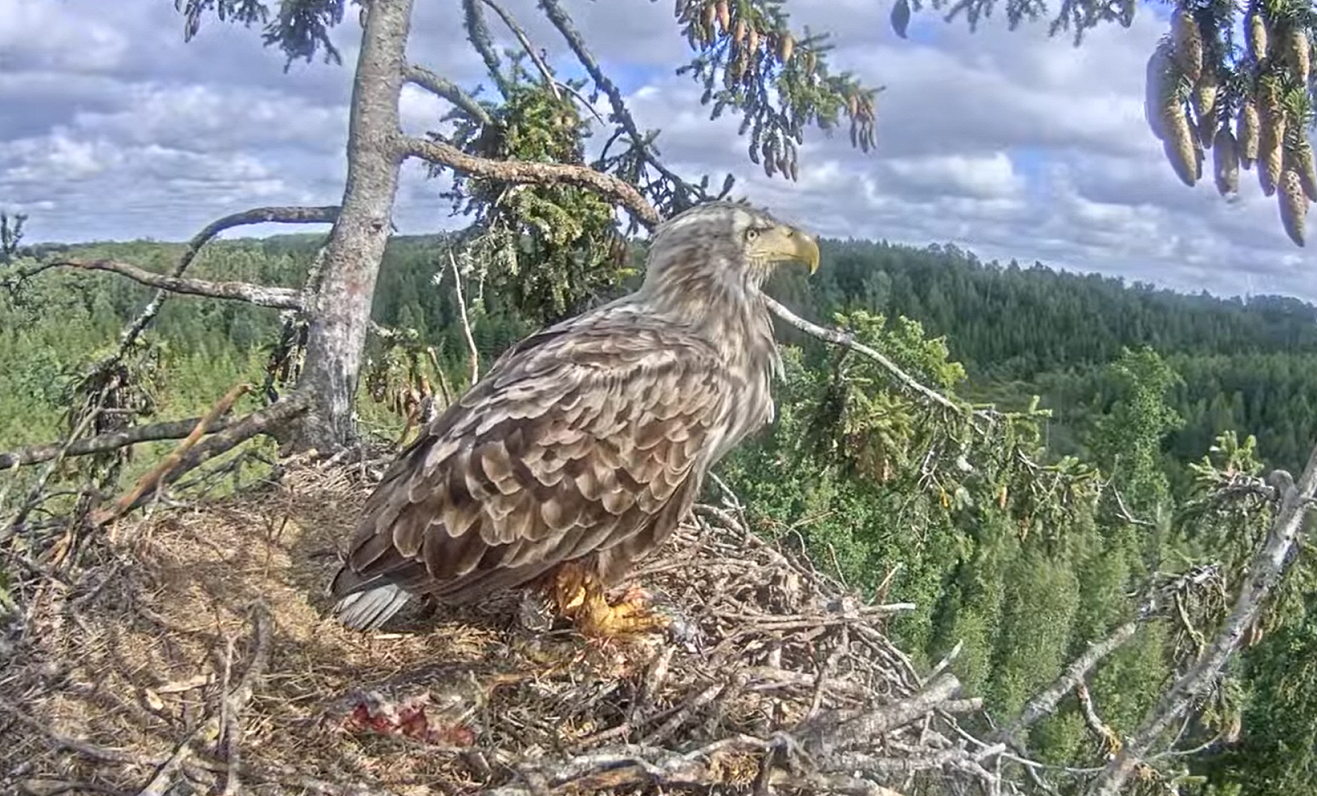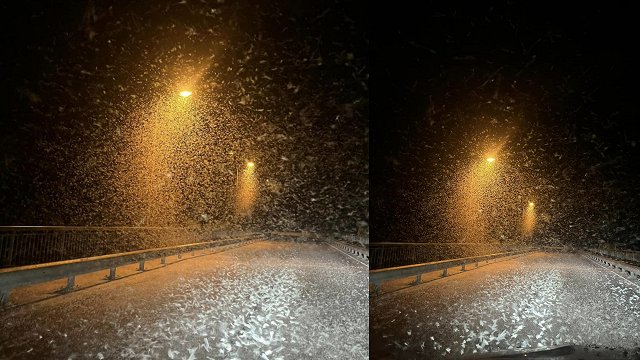On the tenth anniversary of Durbe's nest livestream, the Latvian Fund for Nature offers a brief insight into the history of the nest. As a reminder, the nest of the white-tailed eagle is located in Durbe municipality and was built in an old large-diameter fir tree, about 25 meters high.
2014 - the year the nest was found
A nest of white-tailed eagles was found in Kurzeme, Durbe municipality, built in a pine tree that was left in a clearing. A successful nesting year. One of only four known white-tailed eagle nests in Latvia this year, with three chicks raised.
2015 - the year of Durbe and Roberts
A move was made to an old spruce tree nearby. At the beginning of the year, the nest was being built, which viewers could observe with the help of a live cam. The camera system was deployed at the nest on the night of February 1, and the following days allowed everyone to get to know the homeowners – a female of Estonian origin, ringed in 1999 in Saaremaa, and an unseen male. The birds were named Durbe and Roberts by the users of the Nature Data Forum. On March 9 and 12, two eggs were laid in the nest. On March 18, a crow ate one of the eggs. The other chick hatched on the night of April 15 and was named Durberts [a male name] but later was confirmed to be a female and renamed Durberta. At the end of December, the adult female Durbe disappeared.
2016 - the arrival of the Lithuanian
Intense conflicts began over the ownership of the nest. In the spring of 2015 no mating took place but several young female eagles were trying to start a relationship with the nest owner Roberts. Other eagles, ravens, and other birds visited the nest. Roberts left the nest. In autumn and winter, the inhabitants of the Durbe nest were the white-tailed eagles Vents and Šilute (female from Lithuania, male from Latvia, both ringed). The eagles were working hard on the restoration of the nest, which gave hope for a successful nesting in spring 2017.
2017 - the year of Milda and Raimis
Since January 27, the female Šilute was no longer seen in the nest - the reasons for her disappearance unknown. About two weeks later, Vents also left the nest. The nest was actively fought for, and in March was finally inhabited by Milda and Raimis. It was too late to start nesting, plus other eagles kept barging in. Raimis and Milda spent the rest of the spring and summer regularly staying at the nest, guarding it from other birds and, as autumn approached, repairing and decorating the nest with green branches.
2018 - the year in which Vilnis fell from the nest
In the second half of March, Milda laid two eggs, which hatched on April 29 and May 2. The older chick often bit the younger one, Vilnis, and did not let him feed, but there was enough food and they both grew up. On the night of July 13, Vilnis fell out of the nest, but later, much to the relief of the audience, returned safe and sound. At the end of August, the nest slowly started to collapse, and the older chick Robis or Robe also destroyed the microphone leaving the live broadcast without sound. The nest later collapsed completely, but both old and young eagles continued to visit the nest site, and in late September both adult eagles started working on rebuilding the nest.
2019 - a year of relative calm
The mating season began in January and three eggs were laid in March, two of which hatched in April. The chicks had enough to eat and their strength balance was fairly similar, so life in the nest is relatively calm. Both chicks fledged at the end of July. The nest collapsed again. The eagles started to rebuild it at the beginning of October and it was fully restored by the end of November.
2020 - the year in which the third chick was pushed out of the nest
In the second half of April, all three eggs hatched. As the chicks grew, it was hoped that all of them would fly away, but the two older chicks were aggressive towards the younger one until it was pushed out of the nest on May 17. The young Reinis and Malda fly out in July.
2021 - the year Raimis disappeared
Milda laid three eggs in March. The first blow to successful nesting came on March 27, when several strange birds visited the nest area and, although Milda and Raimis took turns hatching eggs, Raimis left the nest that day and never returned. Milda dutifully continued to incubate her eggs for five days, but in the cold spring, without enough food and in sight of other white-tailed eagles, she did not find it easy. One of the nest visitors, Čips, however, earned the trust of the female eagle. Čips got involved in providing food and eventually also in hatching. The presence of other eagles near the nest and the scarcity of food in April, when the first two chicks hatched, made the birds very anxious. Upon her return, Milda ate the chicks, while the third egg was eaten the next day by another eagle, later named Mr K. Other eagles also visited the nest, but Mr K and Milda continued to visit throughout the summer and autumn.
2022 - the year Milda gets Voldis but no chicks
Milda, the female white-tailed eagle, continued to live in her nest in Durbe. On February 18, Mr K was seen for the last time. Milda was joined by a new and less experienced partner, named Voldis. On March 15 and 18, Milda laid two eggs. Soon, on March 23, a strange female eagle visited the nest and ate the eggs in the presence of Voldis. Both continued to visit the nest, but enjoyed a free eagle life for most of the summer. The nest returned to activity in autumn, when Milda and Voldis started to furnish the nest, giving hope for a successful nesting year.
2023 - the year in which we could hear more than we could see
On March 8, Milda laid her first egg, followed by two more on March 11 and 15 . In mid-April, two chicks hatched, which Milda and male Voldis provided with a good amount of food. On May 4, one of the young birds threw a splatter from his back end in the camera lens, smearing it so thoroughly that it could not be washed away by the rain, so that until the birds grew up, viewers could only guess what was going on in the nest by the sound. In July, when the chicks had already left the nest and the camera was safe to maintain, the lens was cleaned, allowing the view of the successfully grown chicks. The audience gave them the names Kursis and Kate. In autumn Voldis disappears from the territory. The nest fell. At the end of the year, Milda rarely visited the nest tree and another male stayed with Milda.
What will 2024 bring?
In late January and February, mating attempts took place between Milda and the new male, but the nest was still not built. The birds have tried unsuccessfully to rebuild the nest a few times, but so far have not succeeded. There is a possibility that the nest will not be built again and the camera will have to be moved to another location, but it is just as likely that the birds will rebuild the nest again.





























